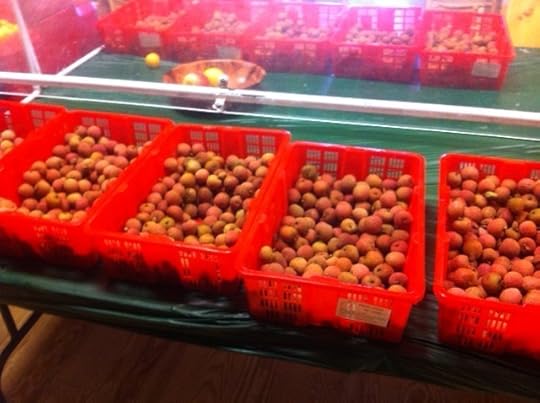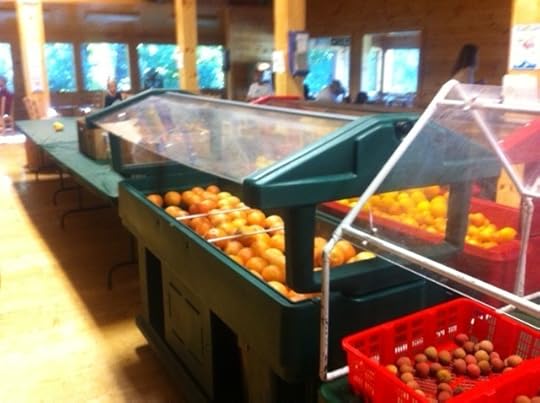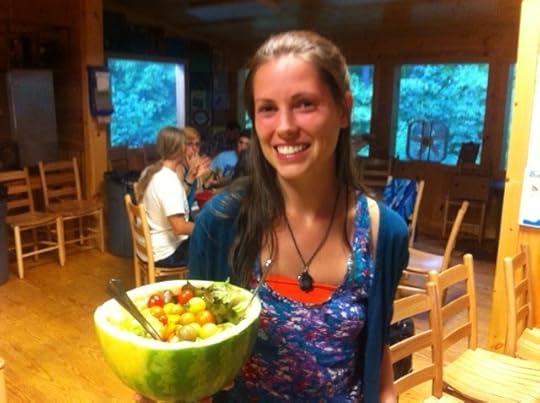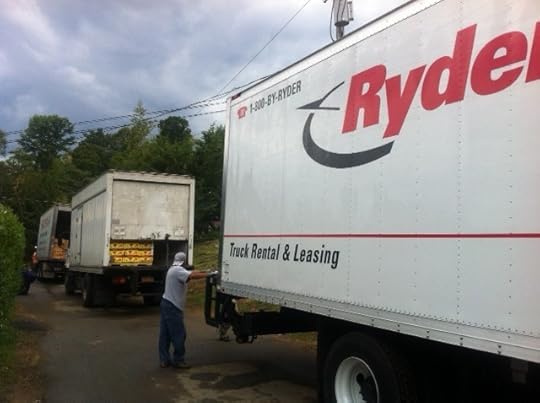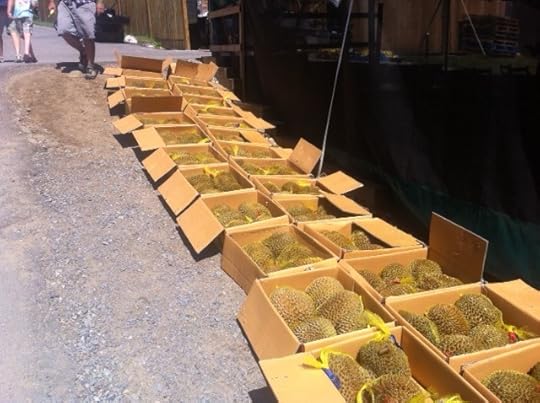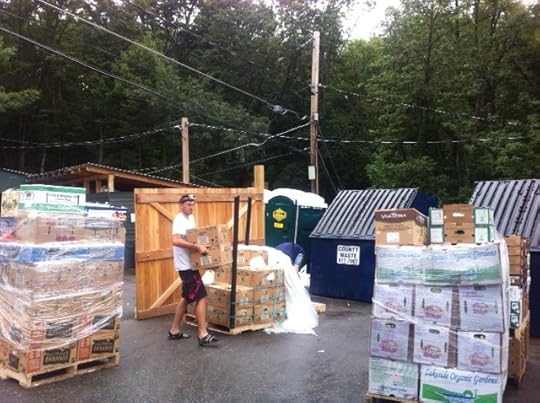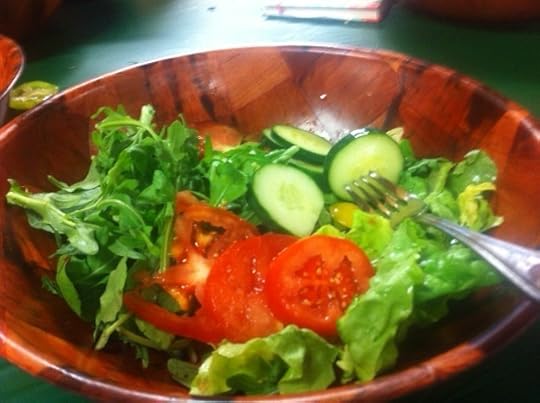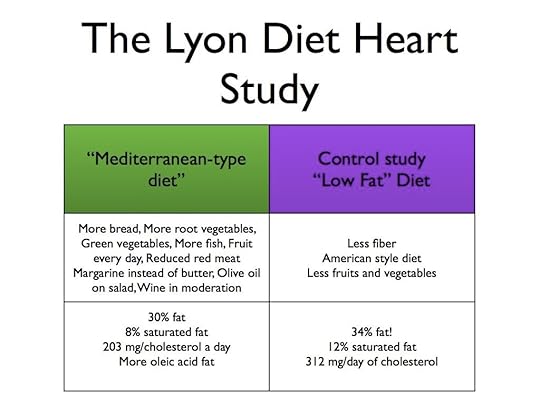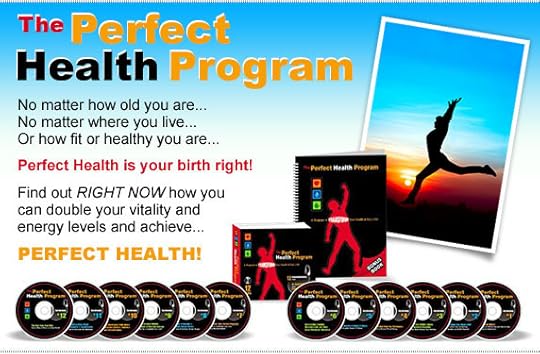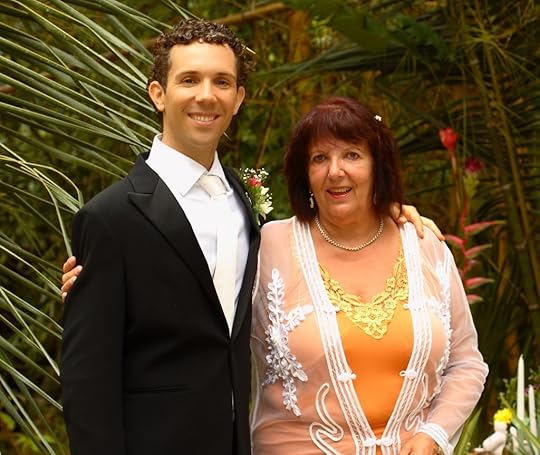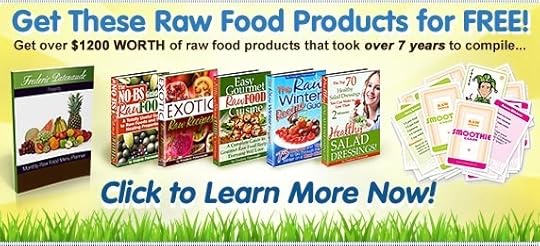Frederic Patenaude's Blog, page 40
September 6, 2012
Prepare for the Winter on the Raw Food Diet
A couple weeks ago, I was at the Woodstock Fruit Festival where I gave a few workshops on the raw food diet and met many of the 400 participants.
Many people asked me where I was going to spend the winter.
Maybe because I used to talk about my life a lot on my ezine, many people were aware that I routinely spent a few months of the winter in Costa Rica or other tropical countries. So quite a few of the great people I talked to asked me if I was planning to go to Costa Rica again this winter, or perhaps some place else.
So I told them, “No, I’m actually not going anywhere this winter.”
They were quite shocked to hear that. Why would I endure an entire Canadian winter when I used to spend at least a couple months in the tropics?
I told them I had other priorities this winter and that I was not planning to leave. I also wanted to see what it would be like to spend another cold winter here in North America.
But secretly, I have a plan to make it work. And I didn’t tell them about that plan, but I’m going to tell you.
First of all, I think the cold seems to be a big issue for raw foodists. Raw foods do make you seem less resistant to the cold, at least at first. And when the days are short and cold, eating a cold breakfast of cold fruit doesn’t seem very appetizing.
I’m doing two things to prepare for the winter:
1) First of all, I’m conditioning my body to withstand colder temperatures using cold showers
2) I’m about to do a 7 to 10 day green cleanse
Let’s talk about the first part… cold showers.
Now that sounds horrible!
I admit that I’m a total wuss when it comes to cold water. I’ve always enjoyed really hot showers and baths. If you read my book Raw Controversies, you know that at some point in my youth my mom got divorced, and for a few winters our heating system in the house didn’t work very well. So I learned back then to warm up using hot baths every morning.
But in reality, hot baths and showers only provided a short-lived relief. I was still cold the rest of the time.
About six months ago, I was at the McDougall Conference in Santa Rosa, California, where I met many famous authors including Dr. Joel Fuhrman.
At the conference, I met a former Nasa scientist, Ray Cronise, who’s featured in Tim Ferriss’ book The Four Hour Body.
Ray is also the co-founder of the company Zero G, that take people up into special airplanes to have them experience a state of weightlessness, like astronauts experience in space. I won’t tell you exactly how that happens because it will freak you out!
Anyway, Ray is also an expert on the benefits of cold water therapy. If you want to read his take on it, check out the Four Hour Body by Tim Ferriss and you’ll read a chapter where Ray is mentioned. That’s the chapter, by the way, where Tim Ferriss is immersing himself in a tub of cold water with ice!
Ray is mostly interested in how cold water therapy can magically help you shed body fat, but it also goes way beyond that.
Here’s Ray Giving a Ted Talk:
So he got me interested in cold water therapy.
However, like I told you before, I was a total wuss when it came to cold water, and even though Ray gave me a very specific method for getting used to it, I just couldn’t do it.
But as I was thinking about the approaching winter, I started doing more research on cold water therapy.
It turns out that this is a very powerful technique that’s been used mainly in Europe for centuries, and one of the reasons why the Russians and Finns are such hearty people.
I won’t go into the details of how cold water therapy may improve other areas of your health. What specifically interests me is how cold showers help you withstand cold weather much better.
How cold you feel depends on metabolism, circulation and a few other factors.
When you train your body to “endure” cold showers, you will increase its cold resistance and circulation. And supposedly it takes about two weeks to adapt.
So I thought: why not do it while it’s still warm outside.
For the past two weeks, I’ve been taking cold showers exclusively. And so far, I can say that Ray was right! It’s working.
It took a little getting used to it, but I’ve been jumping in all sorts of relatively cold lakes lately. And I feel my body is already starting to react differently to cold temperature.
However, you should ask me again how I feel about this in February! I’ll definitely keep you posted on my progress.
2) The second way to adapt to cold weather is going on a Green Cleanse.
This is a bit counter intuitive, but one way to feel warmer is to shed some body fat. This brings the surface of your skin closer to your muscles and organs, which generates heat. So your skin will feel warmer to the touch.
Going on a green cleanse will help you shed some body fat, but it also works wonders for your circulation and skin.
I generally recommend going on some sort of cleanse (green or other) about four times a year, with every change of season. You don’t need to fast completely, but just restrict your diet to one or two categories of food, and do that for about 7 days.
On September 10, we are organizing the last Green Cleanse of the year.
The Green Cleanse includes daily motivation, green smoothie recipes, a discussion forum to connect with other participants, and more.
This is the best way to do it.
Sign up at:
http://www.fredericpatenaude.com/greencleanse.html
NOTE: As a special for this year’s last cleanse, get a $60 discount by using the coupon code SEPTEMBERCLEANSE upon checkout.
Frederic
PS: I promise I won’t have you take cold showers during the cleanse!
PPS: The Green Cleanse starts September 10th, but the deadline is before that, so make sure you sign up this week. Use coupon code SEPTEMBERCLEANSE to get $60 off. Go to: http://www.fredericpatenaude.com/greencleanse.html
August 21, 2012
Pictures from the Woodstock Fruit Festival 2012 Day 2
August 16, 2012
How I Almost Lost My Teeth on Raw Foods
Before I get into today’s article, I want to update you about next week’s Woodstock Fruit Festival! I will spend a week along with almost 400 health seekers in beautiful New York state. Why not come and join the party, meet me and other raw food experts and chat and have a great time? Get the details at: http://www.thewoodstockfruitfestival.com/
I’m about to tell you the incredible story of how I almost lost my teeth on the raw food diet, and what I did to completely reverse the situation and never get another cavity again.
I’ve told parts of the story before, but never did I tell it all in one place.
The most important part of the story is where I will tell you what I did to solve my issues, and the unfortunate fact that many raw foodists and health enthusiasts still refuse to believe that their diet is not more likely to cause dental problems than other diets.
In the summer of 1996, I discovered the raw food diet and started a lifelong passion for natural health. I was 20 years old, and I had just discovered Natural Hygiene through the writings of a relatively unknown author, Albert Mosséri.
This led me to passionately pursue this path and study everything I could on the topic. By the summer of 1997, I had decided to go 100% raw.
And I stayed 100% — without any cheating — for over 3 and 1/2 years.
I was a committed raw foodist. I wanted to make it work. And I even travelled all the way from Montreal, Canada, to San Diego, California, to live this lifestyle and learn everything I could learn about it.
When I first studied Natural Hygiene, I read many books by Dr. Herbert Shelton, one of the most influential writers in this movements. In one of his classic books, he claimed that tooth brushes were doing more harm than good.
After all, aggressive brushing can damage the enamel, and animals in nature have great teeth without using toothbrushes.
Shelton believed that as long as one ate natural foods — like apples and lettuce, teeth would naturally get cleaned and it was not necessary to use a toothbrush.
I thought his reasoning made sense and went along with his philosophy.
But I did not completely stop brushing my teeth. What I did is simply very often neglect to brush my teeth, thinking that chewing an apple was enough to “naturally clean the teeth.”
During my first few years raw, I also ate a lot of food. Initially, I was a simple raw foodist, eating an 80-10-10 diet (without knowing it) of just fruits and vegetables and limited fat.Then in California, I discovered raw cuisine and started eating delicious raw cakes, dips and other recipes. I also ate plenty of dates and amazing tropical fruits, like cherimoyas and durian.
After about two years on the diet, I started experiencing pain in my teeth. But I procrastinated and neglected going to the dentist.
Then another year passed and I finally did.
That’s when I got some shocking news.
I had 19 cavities!
It cost me a lot of pain and money to fix all of these cavities, and at that point I of course realized that Shelton’s advice was horribly wrong, so I started to brush my teeth religiously.
Initially, all of these dental problems made me go off the diet, and I started eating cooked food again.
But it didn’t take too long before I felt inspired to go back on the 100% raw food diet.
Two years then past, and one of my fillings broke. I was eating a grape, and the seed in the grape broke a filling in my mouth. So I reluctantly went back to the dentist, hoping that I wouldn’t have more cavities.
In the past two years, I had been very careful.
After each meal, I would brush my teeth or at the very least swirl water in my mouth to neutralize the acids in fruits.
I thought I was doing pretty good.
But then my dentist had pretty bad news for me again.
I had over 20 NEW cavities!
I was floored.
I almost couldn’t breathe.
I couldn’t believe this was happening to me again.
The cavities were not as deep as the first time, and fortunately nothing required major intervention like root canals. But it was so disheartening to see that all of my efforts over the last few years had been in vain.
Something was terribly wrong!
I had to go back to the dentist four times to get all of my teeth fixed. It was a lot of pain, a huge expense, and just very traumatizing.
At that point, I realized that this was somehow linked to my diet.
So I decided I could not be a raw foodist anymore. I changed my diet completely.
I stopped eating fruit meals twice a day, and instead ate some fruit along with yogurt in the morning.
I had vegetable stir fries and rice for launch.
For dinner, I started to eat animal protein along with vegetables and maybe potatoes. I initially started with eggs, and then ate fish, chicken and red meat.
I did not like this new diet as much as the fruit-based one I was following before. I had less energy, and I felt huge guilt about eating animal products and foods I had initially thought were really bad for health. But I felt I had no choice. If I stayed on the raw food diet, I would probably lose my teeth.
At the time, I started using Toothsoap instead of regular toothpaste, but I did also use a fluoride toothpaste several times a week.
And of course, the main change in my diet was that I stopped being a raw foodist and stopped eating a lot of fruit.
About nine months later, I noticed some brown spots on the base of some of my teeth. They looked like cavities.
I was flabbergasted! Not again!
So I went back to my dentist to get this checked immediately.
Then he told me that I had absolutely no cavities and that in fact, everything was looking great.
“What about the brown spots I asked.”
He said “Those look like what happens what a tooth re-enamelize. It looks like a cavity started to form, but then you did something to stop it so the tooth had a chance to heal. That can only happen when the cavity is very young.”
At that point I had the proof I needed.
Wow!
I had indeed solved my dental decay in its tracks.
However, was it the toothsoap? Was it my use of the fluoride toothpaste? Was it my change of diet?
I felt it was a combination of all these things.
I was happy to have solved my dental problems, but I did not solve my diet problems.
I just wasn’t thriving eating all of this fat and animal products.
But at the same time, I did not want to go back on the raw food diet and risk losing my teeth.
That take us to around 2005, when I met Dr. Doug Graham and went fasting in Costa Rica. When I came back, I decided to eat an 80-10-10 diet and avoid most sources of fat, focusing my diet on fruit and greens.
I was looking forward to see what would happen to my teeth on that diet.
I kept the rest of my dental hygiene routine the same.
After about a year, I went to the dentist, and I had two cavities.
So I had done a lot better, but I had not solved my issues entirely. And I also had the proof that as far as I was concerned, eating a fruit-based diet was causing more decay.
That’s about when I discovered an incredible book called Money By The Mouthful, by Dr. Nara. I eventually acquired the rights to publish this book directly from the publisher, and this book is included in the package “How to Heal and Prevent Dental Disasters,” which is on sale right now for a limited time at: http://www.fredericpatenaude.com/oralhealth.html
The book was a revelation.
It made me understand exactly what had gone wrong and why I was having these problems.
After I followed the advice in the book, I never had another cavity EVER again. And yet, I kept eating a lot of fruit.
You’ll get a much better idea once you read the book, but here’s the basic concepts that I discovered:
1) Dental decay is a disease. It has to do essentially with an “infestation” of a certain type of bacteria in the mouth. When these bacteria are allowed to proliferate, the organize into “colonies” and it becomes extremely difficult to eradicate them if you follow standard dental hygiene protocols.
2) The terrain is everything. The reason I had another 20 cavities just two years after I got 19 cavities, even though I brushed my teeth and was careful, was because I had created such a bad “environment” in my mouth were bacteria were having a party. My little brushing was not enough to eradicate them.
3) Bacteria feed on sugar, which is why the raw food diet is more cariogenic. “Cariogenic” is term used by dentists to describe a diet or condition that causes more dental decay. It’s a simple equation: more sugar = more chance for the bacteria to feed and cause cavities. The type of sugar (white of fruit) doesn’t matter. They will feed on anything.
4) The raw food diet is also more cariogenic because people tend to eat more often. More sugar exposure = more cavities.
5) You have to eradicate the bacteria. The only way to reverse the situation is to create an oral environment where bacteria are in a sort of free-flowing state, not able to accumulate and form plaque. Traditional hygiene routines like brushing your teeth twice a day is not enough to reverse the situation.
It would actually take a while to describe the process.
That’s why I recommend to everyone concerned about their dental health to apply the information in the book “Money by the Mouthful” available at:
http://www.fredericpatenaude.com/oralhealth.html
The sale is on for a few more days. After that, the price will be raised.
July 29, 2012
Legalize Banana Smoothies
This morning I woke up with this incredible craving for bananas!
In the summer, we have so many delicious fruits available, like mangoes, peaches, watermelon, cherries — that I find I don’t desire bananas that much during that time.
Yet this morning, my craving for bananas was so intense that I ended up running to the store to get some.
And then I came back and made this huge banana smoothie.
After drinking it, I got this surge of energy.
I thought, this stuff is so good it should be legalized!
Oh wait, bananas are not a drug…
But they might as well be one, a great natural energy booster.
The best way to get started eating more raw foods is to make giant banana smoothies in the morning. And your smoothies don’t need to contain just bananas!
Use bananas as a staple, but also add other fruits and greens such as:
- Frozen fruits (berries are great)
- Fresh seasonal fruits like mango or peaches
- Baby spinach, Swiss chard, kale
- Fresh herbs (try crazy combinations like basil or mint)
- Fruit that will go bad soon if you don’t eat them (like that wrinkled apple in the back of your fridge)
For variety you can even replace water with some almond-milk. Store-bought almond milk may not be raw, but it doesn’t contain that much fat at all, and adds an incredible, creamy taste to smoothies. You could use it occasionally as a treat — but not all the time.
You just can’t go wrong with banana smoothies. As long as you use ripe spotted bananas as the base and some liquid (1/2 cup to 1 cup), then you can add almost anything but sawdust to the smoothie and it will taste good!
Banana smoothies are excellent after exercise, as a recovery drink. Try adding a bit of fresh celery to it to make it even more like a real recovery drink. Celery adds natural sodium which helps in rehydration.
The great thing about bananas is that they are fairly cheap. By calories, it’s certainly the most affordable healthy choice you can make.
When I lived near Montreal, I would buy an entire 40-pound case of organic bananas at a distributor for around $30-35.
Even if you can’t afford organic bananas, don’t be afraid to buy conventional. Conventional bananas are listed very low on the list of pesticide-containing foods. Due to their thick skin, they are considered pretty safe.
Sometimes, you can find bananas for less than 50 cents a pound! When I was younger, I would often buy them at less than 30 cents a pound in some stores. It seems like the days of really cheap food are over, but at least bananas have remained relatively cheap.
I’m not one of those people who say you must absolutely eat 30 bananas a day.
You just need to eat the amount of fruit that you need, based on your energy levels and your lifestyle.
I personally could not make bananas the #1 staple of my diet all the time, but I enjoy them often and overall, it’s probably the main fruit that I eat throughout the year.
If you’ve procrastinated giving raw foods a try, start with banana smoothies. You’ll love them so much that you’ll wonder when they’ll become illegal!
July 17, 2012
When You’re Hungry You’re Angry
My friend Shelli Stein is a fitness and wellness trainer in Hawaii. Last time I visited her, she gave me an awesome tip that I absolutely loved and wanted to share with you.
Many of her clients have trouble sticking to an healthy diet. What tends to happen is that they find themselves in some situations where they don’t have any food to eat, they get hungry, and then they make bad food choices in that moment.
Shelli says:
“When you get hungry… you get angry!”
That’s why she has her clients take a so called “HANGRY BAG” with them wherever they go. The purpose of the Hangry Bag is to avoid getting hungry and angry and running to the nearest fast food place or corner store.
The Hangry Bag is extremely important if you’re going to drive for a while. Who knows, you could be stuck in traffic and then get hungry and subsequently angry!
Anytime you leave the house for more than an hour, you should have with you a Hangry Bag.
What can go in your Hangry Bag?
- Water
– Raisins
– raw unsalted nuts and seeds
– Dried figs
– Other dried fruits
– Healthy “bars”
– Ginger Chews (to avoid motion sickness and nausea)
– Apples and other fruits that will keep well (crisp apples are the best)
– Etc.
You can take the Hangry Bag to the next level by keeping a mini-cooler filled with cut-up fruit, or put a fresh fruit salad inside of a thermos container to keep it cool to take with you.
The trick to sticking to any healthy diet is to make sure you have food with you at all times just in case! Remember, when you get really hungry, you get ANGRY, and that’s when you can make bad decisions, like going for the chocolate chip cookies at the office, or the chips from the vending machine, or the large Mochachino from Starbucks.
Shelli wants to encourage you to make your own Hangry bag. In fact, she’ll send you a Hangry bag from Hawaii if you can guess what’s in her very own Hangry bag!
I’ll give you a hint: there are only three items in Shelli’s Hangry Bag. One of them is water.
The first person to guess the other two items, will win a Hangry Bag!
Post your comments below.
July 9, 2012
Forget the Hype, Olive Oil Is Not Healthy
One of the biggest LIES we’ve been fed over the last 15 or 20 years in nutrition circles is the idea that olive oil is awesome for health and that we should drizzle it all over everything.
I’m actually surprised that this myth has endured for so long, in spite of the mounting evidence to the contrary.
Watch any cooking show on TV, and you’ll see them lift that elbow faster than an alcoholic with his bottle of Jack Daniels when it comes to pouring olive oil on everything.
In fact, they don’t even calculate how much olive oil they put into things, they just poor random amounts and say:
“So we’re going to drizzle a few tablespoons of Olive oil in our pan before we start frying our organic wild-caught Atlantic salmon…”
And BOOOM!
Look at that elbow bend!
There goes about a a quarter cup of olive oil. I’m not kidding. Their “tablespoons” are magically quadrupled in amounts once they start drizzling that stuff all over.
Sometimes they’ll even mention how healthy olive oil is… “And now we’re going to pour a tablespoon or two of heart-healthy olive oil…”
I mean, does anyone think that Jamie Oliver could cook anything without his olive oil?
At least French chefs in the past knew that putting all that butter in their food was not healthy. They did it for the sake of taste, not health.
Now modern chefs are fooling the populace by replacing butter with olive oil. They’re making things only slightly healthier, but we’re pretty far from “heart-healthy” here.
Why Olive Oil Is NOT Awesome
The idea of olive oil as a healthy food comes from research that’s been done on Mediterranean countries, like France and Greece.
In the 70s and 80s, a lot of research went into trying to answer a mysterious paradox:
Why are some countries consuming a lot of fat, yet experiencing less heart disease than other countries that eat more fat?
It was the beginning of the French paradox.
So there began the Lyon Health Study, the biggest of its kind at the time, that studied over 16 countries in the Mediterranean and found that the island of Crete was the one that experienced the best health at the time (this was BEFORE major industrialization took place on that island).
What the Lyon Health Study did was to compare a “Mediterranean-type” diet, inspired from the data available, to a control study that they labelled a “Low Fat Diet”
They put people in two separate groups. One was to eat the “Mediterranean Diet,” and one the “Low Fat Diet”.
Mediterranean Group: They were instructed to eat more bread, more root vegetables, more fish, more fruit, but reduce red meat, use margarine instead of butter, and olive oil on salad. Wine in moderation.
Low Fat Diet: The so-called “low fat diet” still consumed over 34% of their calories from fat! In my book, that’s not a low fat diet. On the other-hand, the “Mediterranean” group ate 30% fat, and much less cholesterol. The Low Fat Diet was higher in fat than the Mediterranean diet!
What they found is that people in the “Mediterranean” group experienced a dramatic reduction in cardiac death following that diet (50-70% less). So they even had to stop the study, fearing for the health of the control group on their so-called “Low Fat” diet.
What’s interesting is that all of the benefits from the “Mediterranean” diet can easily be explained by the slightly better choices they made: eat more vegetables and fruit, eat less meat, avoid saturated fats.
Here’s where it gets interesting:
- The studies on the Mediterranean diet NEVER proved that olive oil is healthy food in itself
– They only proved that replacing other fats (like butter) with olive oil and margarine is slightly better
– The main message from the study is to eat more fiber, whole grains, fruits, vegetables and exercise!
Even a further study, the Nurse Health Study, shows that women eating olive oil are only marginally healthier than those who don’t.
The truth is that inhabitants of the island of Crete used to be very healthy because:
- Ate lots of fresh produce and some coarse (whole grain) bread
– They ate beans and fish instead of refined foods and fatty meats
– Yes, they added some olive oil to their diet (2 tablespoons a day), but burned it off by walking and hiking on average 9 miles a day!
For your information, I visited the island of Crete in 2010. Now 60% of the population there is overweight. They continue to consume olive oil, but have thrown all of their other health habits out the window. In fact it was pretty hard to get any food there that wasn’t absolutely dripping in olive oil!
What About the French Paradox?
Often we lump all the Mediterranean countries in one big group. But the truth is that these countries are very different.
Think about the differences from Spain to Italy to France to Greece, Turkey, Egypt and Lebanon. Isn’t that weird to lump them all together in one group?
The French people did not eat olive oil. They ate a moderately rich diet and drank wine frequently .
Greek people did not drink much wine, but ate some olive oil.
Now we’ve designed a diet that combines the elements we “like” from these different countries, namely red wine and olive oil. This is NOT a true pre-industrial Crete diet, which was the reference for a healthy diet in the region. The Cretens did not even drink wine, and they were quite poor and ate mostly plant foods.
Olive Oil Goes Straight For Your Lips To Your Hips
Olive oil is concentrated in calories, much more so than sugar. White sugar only contains 50 calories per tablespoon, whereas olive oil contains 120!
When I visited Greece, I found that a lot of people there were overweight. Is it a coincidence that they consume the most olive oil in the world (26 liters per person per year!) Yet, 22% of the population is obese, and it’s growing rapidly.
Olive Oil Should Be Limited
Olive oil, just like any other oil, is concentrated in calories. It’s pure 100% fat, with no fiber and almost no other nutrients.
All oils will raise your cholesterol levels, and according to Dr. Esselstyn, they promote heart disease by damaging the endothelial cells in your blood vessels.
Oils are also not very satisfying. It takes a larger volume of oil to fill you up than water rich foods. Oils are just empty calories, that can add to your body weight quite easily. It’s very easy to use more oil than you think.
Ideally, there’s no reason for most people to use olive oil on a regular basis. If you’re very active, and walk 9 miles a day like the people of Crete used to, then you could burn off one or two tablespoon of olive oil every day. But overall, it’s still better to get fat from whole food sources, like avocados or nuts and seeds. Personally I recommend chia, flax, walnuts and hemp for “heart healthy” whole foods.
Do I Eat Olive Oil?
I personally don’t eat olive oil on a regular basis. I have a bottle of olive oil at home, and I’ve had it for over two years. And it’s still almost full!
Occasionally, I might have some friends over (that aren’t into my lifestyle) and may make a gourmet recipe and use a little bit of olive oil. That rarely happens, but sometimes I do get fancy!
Whenever I go to a restaurant, I ask for food to be made without oil. I know that they won’t be able to fulfill my wish, but at least when I say “no oil” there’s a better chance they’ll use less oil than if I don’t say anything!
I also say “Please no oil garnishes” so they don’t drizzle oil on top of my salad, as is often the case if you don’t mention it.
It’s not that olive oil is the worst food you can eat. In the grand scheme of things, it’s a better fat than many others, like butter. But it’s still not optimal, and most importantly, it represents concentrated calories that you probably don’t need to have in your body. If you’re very active, you can have some. But most people can’t justify the amount of olive oil they use on a daily basis.
Don’t believe the hype… get olive oil out of your life!
Want more information on raw and vegan recipes without the oil? Check out www.LowFatVeganChef.com
Mafia Wars of Olive Oil Fraud
http://www.guardian.co.uk/lifeandstyle/2012/jan/04/olive-oil-real-thing
July 8, 2012
How My Dentist Told Me That My Teeth Were Too Clean
A few months ago, I went for an appointment to the dentist. I’m always a little apprehensive when I go to the dentist, because around 2002-2003 I went through major problems, all caused by eating the WRONG kind of raw food diet, and also following the wrong dental health information.
My teeth have been doing great for a while, but like I said, I have a little anxiety every time I go to the dentist, based on my past experience.
And I was worried this time because I noticed that a lot of my teeth started to have brown spots at the base of them. I was crossing my fingers I wasn’t starting to get more cavities out of nowhere!
The dental hygienist told me I didn’t have any cavities, but she didn’t know what the spots were caused by.
She asked me, “do you drink coffee or tea regularly”
I said no.
She asked “do you drink wine regularly?”
I said no.
She tried to find the culprit to the stains on the teeth, but couldn’t.
Finally the dentist did his own exam, and he discovered what the problem was. He said:
“Your teeth are too clean!”
He explained to me that there’s a class of bacteria that absorb iron and only proliferate when they don’t have competition from other types of bacteria, like the ones that cause decay. This only happens in very clean environments.
This bacteria is harmless, but they can leave brown stains on the teeth due to the fact that they absorb iron.
He said “We don’t usually see that!”
My dentist then told me that I just needed to slack off on my dental hygiene routine. I could simply occasionally skip a brushing session, or not use the oral irrigator every day.
So I left the dentist office pretty happy, with a small bill, and white teeth (they managed to remove the stains manually), knowing that my biggest problem was:
My teeth are too clean!
*They All Have Bad Teeth*
————-
For this weekend, get our course “How to Heal and Prevent
Dental Disasters” for $17 instead of $37. Use coupon code
ORALHEALTH
http://www.fredericpatenaude.com/oralhealth.html
——————
Many raw foodists I have met have bad teeth. Almost all of the raw food gurus I know have had some kinds of dental problems.
I could give you many specific examples, but the list would just go on and on.
Certain gurus and authors, even some that I respect like Dr. Doug Graham, claim that there’s actually no issue with raw foods causing dental problems. They will say that dentists are not overwhelmed with raw food patients!
But that’s simply because the percentage of the population that eats a raw food diet is very small! Yet in that small fringe population, most of them have serious dental problems.
Just go to a raw food festival, and then ask people one-by-one about that.
Then go to a motorcycling festival, and ask people about that.
You will get two different sets of answers! Yes, most people have had SOME kind of dental work done.
But with raw foodists, the issue I see are sudden problems that start shortly after they go raw, that often escalate, leading them to stop eating the diet.
So let’s be absolutely clear:
You are more likely to have dental problems on a raw food diet than other diets!
The reason is simple: there’s just more sugar in the raw food diet.
Now, I don’t think that fruit sugar is bad for you, but most of us have too high of a bacteria count in our mouths to begin with! This may not be a problem on a diet of chicken and bread, but with raw foods — and all the acidity and sugar in fruit, it can be a disaster.
Another way to look at it is this:
You have to be in great health and have AWESOME teeth to eat a raw food diet and NOT develop dental problems. The average person will have those problems.
The great thing is that you can reverse it.
You could even have the inverse problem, like me. My teeth were simply TOO clean not only for decay, but in fact to remain perfectly white.
Teeth like mine can’t decay — pure and simple.
Now, I had to make modifications to make sure they stay white (by the way, the brown spots were not visible in my smile, because they were at the base of the teeth).
I have to let my bacteria count grow only a little bit!
But most people don’t have my problem, because they don’t know what I know.
When I first experienced dental problems on the raw food diet, I went on a quest to find answers. This led me to publish the program “How to Heal and Prevent Dental Disasters in 21 Days or Less.”
This program will teach you everything.
It’s on sale right now, check it out at:
http://www.fredericpatenaude.com/oralhealth.html
Make sure to use coupon code ORALHEALTH to save $20 this weekend only.
Normally, the program costs $37.
This weekend, the price is $20 if you use coupon code:
ORALHEALTH
July 5, 2012
Why Dehydrated Foods Are Not Optimal
Last month I was with some friends at Kitsilano Beach in Vancouver for the summer solstice. In case you don’t know, Kitsilano beach is this awesome beach in Vancouver that faces the ocean, downtown Vancouver and the beautiful North Shore mountains. On a sunny June day, you can lie on the beach and enjoy the warm sunshine, and at the same time look at snow capped mountains.
This was one of those days.
I ended up meeting a few people who knew who I was and had discovered my website. One guy had discovered my website a couple of years ago and had become a raw foodist himself.
He said he enjoyed my writings, and had remembered me saying something against dehydrated foods.
“I know you said something about dehydrated foods on your website, but I don’t remember why you said we shouldn’t eat them. I couldn’t live without my bag of dehydrated goodies!”
Then he pulled out a bag containing all kinds of dehydrated foods, such as dehydrated apple slices with cinnamon on top, and even a sort of dehydrated cabbage “cake”, sort of like a rice cracker.
Many raw food enthusiasts make heavy use of the dehydrator. And that’s a mistake. You shouldn’t go from using the oven and the stove to using the dehydrator for your main source of prepared meals.
I’m not 100% against dehydrated foods. I still use a dehydrator a few times a year, for the very few recipes I make that require it.
I also occasionally eat dried fruits, such as raisins, figs, and apricots.
But in general, I don’t eat dehydrated foods. And here’s why:
1) Dehydrated foods have lost their water. The main benefit of a raw food diet comes from eating water-rich foods that are easy to digest. Dehydrated foods defeat that purpose!
2) Because dehydrated foods have lost their water content, it’s easy to overeat them. They don’t fill you up in bulk like ripe, fresh fruit or large salads.
3) Dehydrated fruits are concentrated in sugars and can be difficult to digest, leading to a lot of intestinal gas and other problems when you eat more than a few pieces.
4) Dehydrated foods get stuck to teeth and promote dental decay. People I know who eat the most dehydrated foods have the worst dental health.
5) Most dehydrated raw food snacks are unhealthy, as they contain too many nuts, seeds and oils. Flax crackers contain even more fat than regular, store-bought crackers!
There are just no reasons to eat dehydrated foods constantly if you have healthier options available, such as fresh fruit.
Instead of bringing a big bag of dried dates everywhere, take some time in advance to cut up some melons, pineapple, peaches, or other fresh fruit! Take that with you instead of the dehydrated foods. To know exactly what to eat and how to make it work, refer to the information in my Raw Health Starter Kit.
That being said, you don’t need to avoid dehydrated foods completely.
- Dried fruits can be excellent “emergency foods,” especially good to keep in your car, or bring with you on a hike when you have little space, or take with you on a plane or a bus.
- You can make delicious seasonings with dehydrated vegetables to sprinkle on top of soups and salads to replace salt. I showed you how in my DVD series The Low Fat Vegan Cuisine.
Remember that dried fruits are concentrated! Most people shouldn’t eat more than a 5-6 dried figs at a time, or 10 dates. People eating giant bags of dried fruit at once are inviting intestinal and dental disasters!
Remember that dried foods will stick to your teeth, so brush them immediately after eating them, or chew on something solid, like an apple or some celery sticks, to naturally wash away the residues.
And please, don’t just dehydrate a bunch of random stuff together into a giant raw pellet. That’s just gross!
To discover the healthiest raw food diet, the best set of resources is the Raw Health Starter Kit. Check it out at: http://www.fredericpatenaude.com/starterkit
June 26, 2012
How my Mom Lost 55 Pounds On a Low Fat Vegan Diet
It’s often difficult to convince our loved ones to make changes that we know they desperately need to make to improve their health.
It’s even more difficult to see someone you love experience health problems in spite of knowing all of the right information and even accepting its validity!
I became a vegetarian at the age of 18 because of my mom, who at the time took an interest in healthier eating.
At the time, she was accumulating all sorts of great vegetarian and vegan recipe books and really tried to change her diet.
This is how I started my interest in vegetarianism. Soon after, I became a raw foodist! And over the years, I’ve never stopped my interest in healthy eating and natural health.
Even though my mom had me as an example and knew all of this information about healthy eating, she kept gaining weight every year!
Her weight kept going up and up to the point where she became obese.
I kept pushing her to make changes — and she even knew what changes to make — but a few things were holding her back:
* She always used food as gratification and therefore delayed changing her diet. “Oh, I have a vacation next week so I can’t really do it now, but right after I come back from the vacation I’ll get started!”
* She became confused about what to eat. Even though she started with the best intentions, conflicting dietary advice eventually got to her. She didn’t eat terribly bad, but the few mistakes she made were enough to tip the balance scale in the wrong direction!
* She felt powerless. Even though I kept trying to help her, she told me, “You know what Frederic, don’t beat yourself up if you can’t change me. This is my problem… I know you’re trying hard. It’s not your fault, it’s mine.”
Over the years, I kept trying to help her.
One time, she even agreed to go 100% raw for a month. This had mostly positive results but she couldn’t stick to it.
She kept telling me that I did “everything I could” to try to help her and really the ball was in her camp now to change.
But deep inside, I felt like I hadn’t done everything I could. I didn’t give up.
When my dad died last year, it was a big shock to my mom. How could someone so young pass away so suddenly?
It was a wake up call. Here’s her at my wedding day, in 2010.
Shortly after, she visited me in Vancouver and spent a week there. During that time, I told her:
This week, you’re going to eat like us! I want to show you how easy it can be to eat healthy. And when you go back home to Montreal, I’ll put you on a program that will really make a difference.
Initially, she was reluctant. “I’m on vacation!” she complained.
But because she liked the food, it wasn’t so much of a struggle.
Between that and a few intense conversations, I managed to convince her to try a new approach.
When she got back home in September, she was on the program.
Every week, she would call me and tell me how much weight she lost! 10 pounds, 12, 15, 20… the weight just kept falling off effortlessly.
When I saw her in June, she was a transformed woman!
* She lost 55 pounds
* She went from a pre-diabetic condition to totally normal blood sugar
* All of her other markers (like cholesterol, etc.) are healthy now
* Instead of being tired walking long distances or hills, she now walks every day and has more energy than ever before
When you say that you can “totally transform your life,” it may sound a little cliché.
But lose 55 pounds, and I guarantee you that you’ll transform your life. Nothing will ever be the same. You’re not the same person anymore!
How Did My Mom Lose 55 pounds?
In the past, I tried to get her to eat more raw foods, try smoothies, and even go raw at times. But it didn’t work.
I realized:
The raw food diet is great for a lot of people, but totally unrealistic for many.
So I gave my plan a simple plan that worked. In essence, here’s what she did.
Forbidden Foods
I gave her a list of foods to “avoid.” this included:
Dairy products (including yogurt, milk, cheese, etc.)
Meat
Chicken
Fish
Bread
Anything made with flour (except pasta)
Oil
Nuts, seeds, nut butters
Avocados, coconuts, olives
Refined sugars
Foods to Eat
Then I gave her a list of foods to eat in unlimited quantities.
Fruits
Vegetables, Salads
Beans, Legumes
Whole Grains
And that’s it! Of course, more went into this, but this is the basic program.
My Mom’s Diet
My mom learned a few tricks of her own to make it work. One was to eat a late dinner, that way she would avoid late-night snacks. Her diet looks something like this:
Breakfast:
Oatmeal with a ton of fruit
Lunch:
Salad or nothing.
Dinner (around 7 or 8 p.m.)
A big starch+vegetable dinner, such as low fat vegan chili, morroccan couscous, and other recipes from the Low Fat Vegan Chef.
After Dinner: After dinner, she generally has another big bowl of oatmeal with fruit, or just fruit, or sometimes low-fat cereal with almond milk
The Learning Curve
At first, it was a learning curve for her. She had to learn how to avoid the fat in most recipes. For example, she discovered how to make hummus without the usual tahini, and made it taste pretty good.
She tried a lot of recipes designed by my wife Veronica, such as the ones included in our Low Fat Vegan Comfort Soups recipe book.
She eventually learned to create recipes of her own.
My Mom’s Tips
My mom, who speaks only French, wanted to share a few tips for success with you.
1) Keep it simple. Make a big batch of something and eat it throughout the week. Variety is often the enemy of success when it comes to weight loss. Find something you like and eat a lot of it.
2) Eat the same thing for breakfast, every day.
3) Always have in the fridge a big fruit salad.
3) Always have in a fridge cut vegetables and green salads.
4) You can use spinach leaves instead of “rice” as to eat under a recipe like vegan chili.
5) Don’t be afraid to eat a lot. You’ll lose weight anyway following this program.
6) Always put more vegetables than the recipe calls for!
Cheating
I knew my mom wouldn’t follow this diet 100%, and she didn’t. But she succeeded anyway. The difference was that when she “cheated,” it was truly when she had no choice in some social situations, and she made the best choice she could in the moment. Food was no longer about “reward.” If she wanted to have something forbidden, she waited for a time when she could truly enjoy it.
The Keys to Success
One key to success to my mom’s weight loss program was its simplicity. I just gave her a list of foods to eat and a list of foods to avoid.
I told her to walk more often, but did not bother her with exercise guidelines.
One key was the absolute avoidance of fat. She had enough essential fatty acids stored up for a lifetime, so I did not have her supplement with unnecessary essential “oils.”
Fat is an impediment to weight loss, much more so than sugar. Fat is concentrated calories that add almost nothing to your feeling of fullness, and can just as easily be skipped in most recipes. One tablespoon of white sugar is only 50 calories, compared to 120 in a tablespoon of any oil!
When someone needs to lose a lot of weight, they don’t need to consume any concentrated calories. That’s why I eliminated all nuts, seeds, avocados, olives, durian, and any other fatty food.
When she reaches her ideal weight (she still has 15 pounds to lose), then she may be allowed to have some fatty foods on occasion.
Unless you’re active and at your ideal weight, eating more fat is NOT the answer. Cutting it out completely may just be what you need.
From Obese to Healthy Weight in less than 8 months
I was shocked to discover that my mom went from being “obese” to only slightly overweight according to BMI guidelines in just eight months! In fact, she only has 6 pounds to lose at this point to be considered at a “normal weight” according to the BMI guidelines.
A healthy weight is one of the many rewards of a healthy lifestyle.
Raw food is one path to health, but it’s not the only path. Whatever you do, choose low fat plant foods. Optimize the amount of raw foods to your liking. Many people thrive on a 100% raw food diet, but it is unrealistic to expect everybody to be able to follow such a program. Others are happy with 80% raw, while many can do extremely well on even less raw food.
The key is to follow a low-fat, vegan diet free of refined and processed foods.
In this article I gave you a quick overview of my mom’s program for losing weight. Would you be interested in finding out everything else that went into it?
As part of my Raw Vegan Mastery Program, I’ll be releasing a video called “How to Lose Weight on a Plant Based Diet” — This video will teach you not only exactly what you need to know, but will also show you practical recipes to get started. If you’re a member of Raw Vegan Mastery, you’ll get access. If you’re not yet a member, click the ad below to find out more.
Frederic Patenaude's Blog
- Frederic Patenaude's profile
- 11 followers



